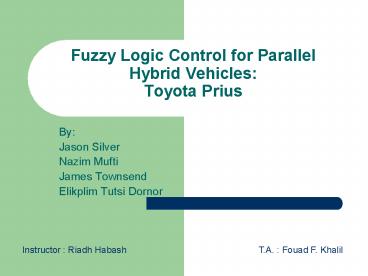Fuzzy Logic Control for Parallel Hybrid Vehicles: Toyota Prius - PowerPoint PPT Presentation
Title:
Fuzzy Logic Control for Parallel Hybrid Vehicles: Toyota Prius
Description:
... specifications of the Toyota Prius. ... design a dynamic car model and powertrain model. ... power % between ICE and EM, using specs of the Prius ... – PowerPoint PPT presentation
Number of Views:261
Avg rating:3.0/5.0
Title: Fuzzy Logic Control for Parallel Hybrid Vehicles: Toyota Prius
1
Fuzzy Logic Control for Parallel Hybrid Vehicles
Toyota Prius
- By
- Jason Silver
- Nazim Mufti
- James Townsend
- Elikplim Tutsi Dornor
Instructor Riadh Habash
T.A. Fouad F. Khalil
2
References
- 1 Niels J. Schouten, Mutasim A. Salman, and
Naim A. Kheir, Fuzzy Logic Control for Parallel
Hybrid Vehicles in IEEE TRANSACTIONS ON CONTROL
SYSTEMS TECHNOLOGY, VOL. 10, NO. 3, MAY 2002 - Basis of our system design., Provided us with the
rules and conditions for the fuzzy logic
controller and the power controller. - 2 http//www.toyota.ca, retrieved on March 7,
2007 - Used to retrieve specifications of the Toyota
Prius. - 3 B. K. Powell, K. E. Bailey, and S. R.
Cikanek, Dynamic modeling and control of hybrid
electric vehicle powertrain systems, IEEE Contr.
Syst. Mag., pp. 1733, Oct. 1998. - Used to better understand hybrid vehicle
modelling. Authors design a dynamic car model and
powertrain model.
3
References
- 4 C. C. Lee, Fuzzy logic in control systems,
IEEE Trans. Syst., Man, Cybern., vol. 20, pp.
404435, 1990. - Used to help in the design of the fuzzy logic
controller. Authors implement a fuzzy logic
controller in a control system. - 5 B. M. Baumann, Intelligent control
strategies for hybrid vehicles usingneural
networks and fuzzy logic, Masters thesis, Dept.
Elect. Eng.,Ohio State Univ., Columbus, 1997. - Used to help in the design of the hybrid vehicle
and fuzzy logic controller. Authors developed a
fuzzy logic control technique for the powertrain
of a hybrid vehicle.
4
Parallel Hybrid Vehicle (PHV)
- Electric Motor (EM) and Internal Combustion
Engine (ICE) combined in parallel
- Advantages
- Very efficient
- Environmentally friendly
- Quiet
- Disadvantages
- Lower performance
- Expensive
- Requires complicated control system
5
Our Control System
- Designed with the specifications of a Toyota
Prius. - Methods
- Pseudo Feedback
- (Jason Silver Elikplim Tutsi Dornor)
- Fuzzy Logic
- (Nazim Mufti James Townsend)
- Energy Management System
- (Elikplim Tutsi Dornor Nazim Mufti)
- Simulink Implementation
- (James Townsend Jason Silver)
6
Fuzzy Logic Controller
- Designed using Sugeno Controller in Simulink
Fuzzy Toolbox
7
Fuzzy Logic Controller
8
Fuzzy Logic Controller
- Inputs
9
Fuzzy Logic Controller
- Outputs
- Generated Power (Pgen)
- This value depends on the inputs above
- Ranges from 0 to 40 kW
- ScalingFactor
- Depends on State of Charge (SOC) only
- Ranges from 0-1
10
Pseudo Feedback
- Needed to generate inputs for the Charge Decision
Block - Input
- Throttle (taken in as Pdriver)
- Ranges from 0 -100kW
- Electric Motor Speed (Wem)
- Ranges from 0 1000 rad/s
- Output
- Pem (EM power)
11
Charge Decision
- Decides whether SOC should increase or decrease
- Decrease EM operation as motor
- Increase EM operation as generator
- Input
- Pem (from Pseudo Feedback)
- Output
- Dynamic SOC
12
Charge Decision Block
13
Energy Management System
- Generated Power and Scaling Factor come from the
FLC - Pdriver comes directly from the initial driver
inputs - The system delegates power between ICE and EM,
using specs of the Prius
14
Energy Management System Block
15
Top Level Design
16
Top Level Design
- Initial Inputs
17
Top Level Design
- System Outputs
18
Conclusion
- From the graph above it is shown that the
controller successfully delegates power to the EM
and ICE efficiently - SOC remains optimal
- Limitations included lack of information in the
power controller design































